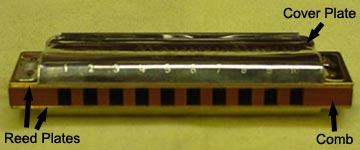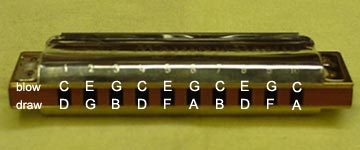

Harmonicas have a simple construction. The cover plate is the outer shell of the instrument. Its primary purpose is to hold the other parts of the harmonica together and it is usually made of metal. . The body or comb of the instrument provides the holes to blow or draw air, these can be made from wood or plastic, or metal. Materials used for the comb of the harmonica have their own tonal characteristics and unique quality. Wood typically produces a resonant, full-bodied timbre with an even note reproduction from lows to highs. A plastic comb is characterized by a warm, even sound while being smooth on the lips. Also available are metal bodies or a metallic finish which produce a bright and clear sound.
 |
The reed plates are sandwiched between the cover plates and the comb. In a standard diatonic harmonica, there are two reeds for each hole-- one used on draw notes and the other on blow notes. The pitch and resultant scale of the harmonica is directly related to two factors; the material that the reeds are made of and the length of the reed. Metal is the most common material used for reeds in instrument quality harmonicas. The length of the reed determines the pitch; that is, the longer the reed, the deeper the pitch.
One of the unique features a harmonica can offer is double row of free-standing reeds. A free-standing reed is attached to the instrument on one end with the opposite side standing "free" so that it may vibrate as air rushes around it. Stacking two reed plates allows the instrument to produce a tone as air is blown or drawn across it.
The standard diatonic 10-hole harmonica has a unique layout of pitches that can be traced back to Richter's "Vamper." Richter's layout was truly ingenious in that chords could be played at any position on the harmonica, but a full scale is located at the center of the harmonica so that melodies can be easily played. His design is the standard for all 10-hole diatonic instruments to this day.
 |
There are, of course, other scale patterns available in harmonicas. Chromatic harmonicas allow the player to play in any key using one harmonica. Chromatic models provide the complete 12 note octave with all sharps and flats. In harmonicas of this style, each hole contains four reeds: two are for natural notes and two for chromatic notes. The reeds for chromatic notes are brought into operation by pushing a slide button on the side of the harmonica. This closes off the airflow from one set of reeds and permits the other set to vibrate freely.